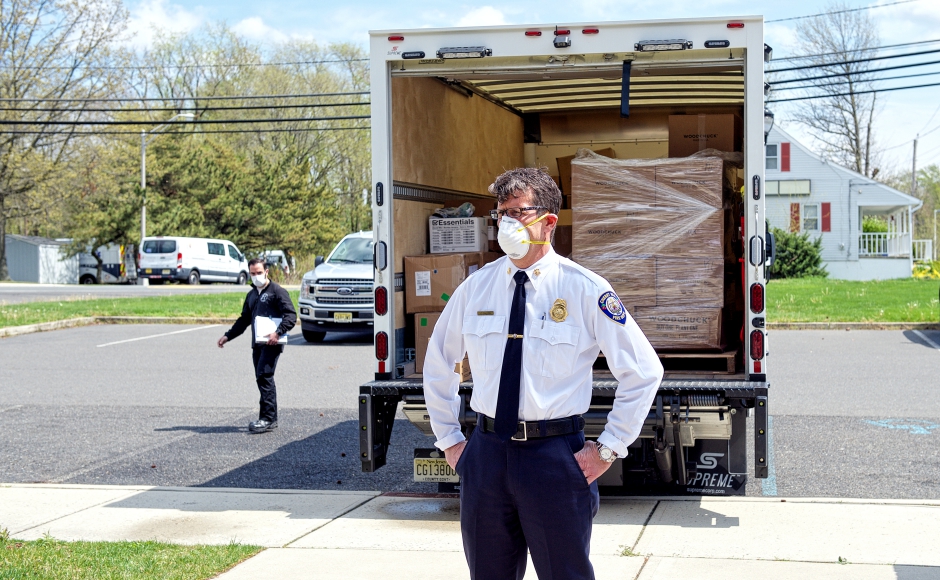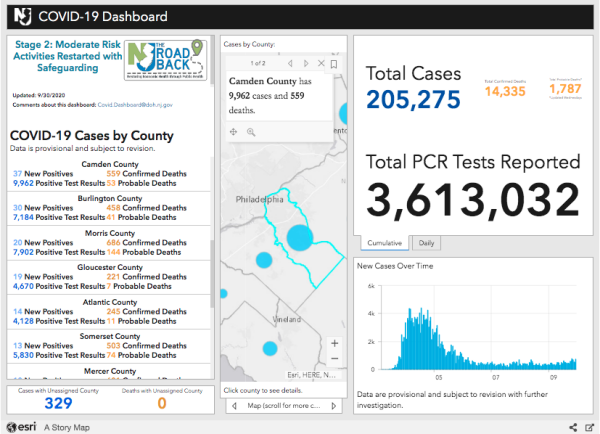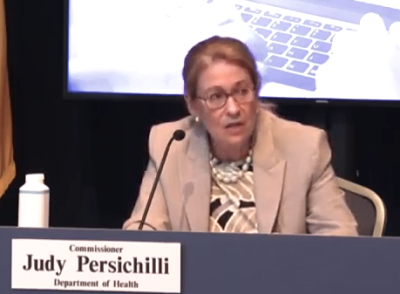Plus: state health officials investigate high numbers of new positive infections in Ocean and Monmouth Counties, with an eye on Lakewood Township, where 27 percent of the population is COVID-19 positive.
By Matt Skoufalos | September 30, 2020
Another 722 New Jersey residents have tested positive for novel coronavirus (COVID-19), bringing the statewide total to 205,275 cases, Governor Phil Murphy reported Wednesday.
Sadly, nine more residents have perished from complications related to the virus, bringing the statewide death toll to 14,335 lives lost during the pandemic.
In addition to those lab-confirmed fatalities, the state has acknowledged another 1,787 probable COVID-19-related deaths, down by four from previously reported levels.
In the past six months, 266 of every 100,000 New Jersey residents have been hospitalized with COVID-19, and 163 of every 100,000 have died from COVID-19-related complications.
More than 3.6 million people have been tested for the virus statewide, with a 2.33-percent positivity rate per 100,000 residents.
Rate of transmission (Rt) at 1.15, spot positivity lowest in South Jersey
The statewide average of COVID-19 spot positivity testing stood at 3 percent September 26, the highest it’s been since July 17.
As a region, South Jersey sported the lowest spot positivity in the state on that date, at 2.40 percent. At 3.79 percent, the central region was highest.
Rt, the variable that describes the seven-day, rolling-average rate of transmission of new COVID-19 cases, hit 1.15 from samples taken September 28.
An Rt figure greater than 1.0 means that each new COVID-19 patient is infecting more than one other person, on average, and the spread of the virus is increasing.
Since its mid-April COVID-19 spike, the highest reported RT in New Jersey was 1.48, recorded August 1. The lowest was 0.62, recorded June 9.

At the Camden County Office of Emergency Management, Cherry Hill Fire Chief Chris Callan oversees a delivery of personal protective gear for long-term care sites. Credit: Rich Ratner.
Long-term care accounts for half of all deaths, a fifth of those infected
Throughout New Jersey, 479 people currently are hospitalized with a case of COVID-19: 271 have tested positive for COVID-19, and 208 are awaiting confirmation of their symptoms.
Among those hospitalized patients, 108 are in intensive or critical care, and 39 of the ICU and critical-care patients (36 percent) are on ventilators, a slight uptick from the prior two weeks, said New Jersey Health Commissioner Judy Persichilli.
Across the state, 725 long-term care (LTC) centers have reported at least one case of COVID-19, and 160 are dealing with an active outbreak. LTCs account for 38,762 infected patients and staff in New Jersey, or 20 percent of total cases.
That includes 25,134 residents and 13,628 staffers sickened by the virus, as well as 7,160 lab-confirmed resident and staff deaths (50 percent of the statewide total), with facilities self-reporting 121 staff deaths.
Of 656 veterans residing in a state-run home, 390 residents have tested positive for COVID-19, and 146 have died from complications related to the virus. Five veterans presently are hospitalized with COVID-19, and 243 have recovered from the virus.
At state-run psychiatric facilities, 214 of 1,175 patients and 524 staff members have tested positive for COVID-19. Thirteen patients and seven staffers have died from complications related to the virus.
“We remain concerned about the number of active outbreaks reported in long-term care facilities, assisted living facilities, and dementia homes,” Persichilli said, noting that the state health department is “currently revising its long-term care directive” for those settings.
To date, 58 New Jersey children aged 1 to 18 have been diagnosed with pediatric multisystem inflammatory syndrome, Persichilli said.
All those pediatric patients have tested positive for an active COVID-19 infection or the presence of COVID-19 antibodies, indicating exposure to the virus. No deaths have been associated with this syndrome in New Jersey, although several children have been hospitalized during their treatment.
11 COVID-19 outbreaks across 11 schools in nine counties
On Wednesday, the state health department unveiled a new component of its COVID-19 dashboard designed to track transmission of the virus that originated within public schools.
The dashboard tracks “confirmed outbreaks associated with in-school transmission,” Persichilli said, outlining the requirements for defining them as such.
A school-related outbreak involves “an epidemiological link within the school setting,” she said. Such a link is defined as at least two confirmed student or staff cases of COVID-19 within a two-week period, originating on school property and in the context of academic activities.
To qualify, those laboratory-confirmed COVID-19 cases must have occurred among students or staff who do not share a household and who are not close contacts of each other in another setting.
Since August, New Jersey has logged 43 new COVID-19 infections across 11 schools in nine counties throughout the state: three in Cape May County, two each in Burlington and Gloucester Counties, and one each in Bergen, Ocean, Passaic, and Sussex Counties.
A single case is not enough to shut a school down by itself, Persichilli said. School closure remains a local decision that should be made by school officials in contact with local health officials.
“The outbreaks are actually what drive public health actions, not necessarily the number of cases associated with the outbreak,” she said.
The governor described the report as “probably as good as I would have hoped,” adding that it “gives us further confidence” that districts can reopen safely in the future.
“We knew going in that there would be positive cases in our schools, and our overarching aim remains ensuring that our schools do not themselves become the epicenters of new outbreaks,” Murphy said.
Interim Education Commissioner Kevin Dehmer was similarly optimistic about the preliminary findings.
“We’re talking about roughly 3,000 schools, roughly two months worth of complete data,” Dehmer said. “Eleven outbreaks, which is two or more cases, is pretty good numbers.”
Of 802 New Jersey school districts that have finalized their reopening plans with the state:
- 403 (50 percent) feature a hybrid of remote and in-person instruction
- 278 (35 percent) are fully remote
- 81 (10 percent) are offering in-person instruction only
- 40 (5 percent) are offering a combination of any of the above models
Nine other districts have yet to finalize their plans with the state.
Lakewood driving high positivity in Ocean County
Ocean and Monmouth Counties continue to lead New Jersey in new positive test results, with the township of Lakewood in Ocean County individually reporting a 27 percent positivity rate.
Dr. Ed Lifshitz, who heads the New Jersey communicable disease service, said Ocean County in general, and Lakewood in specific, has had “issues with communities moving back and forth” among communities in Rockland County, New York, which has one of the highest per capita rates of coronavirus infection in that state.
“[Lakewood] is the fastest-growing community in our state, and one of the fastest-growing communities in the country,” Murphy said. “It’s a dense community going through a period of religious holidays, [and home to] a school district that is fully back in.”
The governor urged New Jersey residents to continue doing their parts individually to tamp the spread of the virus.
“We’re all one family,” he said. “Whether it’s community A or community B, we need to all root for each other.”
Read our ongoing round-up of COVID-19 coverage here.
Please support NJ Pen with a subscription. Get e-mails, follow us on Facebook, Twitter, and Instagram, or try our Direct Dispatch text alerts.








